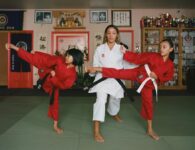
Can you participate in group or partner martial arts training while maintaining social distancing? The short answer is “sort of.” Currently, we are not able to train in the same way we did before the pandemic, but that doesn’t mean that we have to give up on training together entirely. We just have to be more creative and proactive about it!
We’ve spent a lot of time in this blog talking about solo martial arts drills and ways to exercise alone at home. We’ve also looked at how to enlist non-martial artist family members and roommates in our training. But we know that’s not quite the same as training with your martial arts teammates. And we are all eager to get back to training and participating in our communities. So let’s start to look at ways that we can train together while respecting current health and safety guidelines.
Here are five ways to practice social distance martial arts:
Take Online Martial Arts Classes
Virtual classes might not perfectly recreate a gym training environment, but they are the closest thing we have at the moment. They’re also a great way to stay in touch with your martial arts community, and to motivate each other. Many martial arts gyms have already started to embrace technology and are offering online group classes through video conferencing platforms like Zoom and Skype. Many gym owners and instructors are now considering keeping up their online training even as gyms start to open up again. This will offer an alternative to students who don’t feel comfortable in a physical group training setting for whatever reason.
If your gym doesn’t currently offer online group training, don’t be afraid to ask the owner(s) or your instructors if they have any plans to start — or if they’d consider it. If not, you also have the option of seeking out other gyms and instructors who are teaching online. Maybe you can join a class from a faraway gym that you’ve always dreamed of visiting in person. Or maybe you can use this time to take beginner classes in a martial art that you’ve been curious to try.
A couple of the athletes we talked to for our blog post “Training At Home: Checking In With Some Of Our Favorite Martial Artists” have been using Zoom and FaceTime for their training. You can read what they had to say about the experience here.
Try A Private Lesson
If group online training doesn’t work for you, or you’re looking for additional martial arts challenges and opportunities, you can also consider one-on-one training through apps like Skype or FaceTime. If it fits your budget, see if your favorite instructor is offering private online sessions. Or look into what else is available out there. In addition to instructors, some individual martial artists have begun offering their own online training sessions to keep them busy during this downtime. Which means that we now have a unique opportunity to learn from some of the most interesting and successful minds in martial arts.
Here’s an example of how one gym is setting this up for their students:
FaceTime Or Skype With A Training Partner
We can also learn from our training partners and teammates in an online setting. Book a training date with a partner and work on a routine together. Or take turns evaluating each other’s form and offering constructive criticism. It might sound a little weird, but Skype training has a history that began long before our current situation — and it has proven results. For one great example, Emma Teo and Kieran Tamondong’s Team Sync Forms and Weapons Overall winning efforts in the 2016 AKA Warrior Cup were designed and rehearsed almost entirely through Skype.
Emma and Kieran discuss the benefits and challenges of virtual martial arts practice in our post-tournament interviews with them found here and here. You can see the results below:
Host A Watch Party Or Start A Martial Arts Book Club
In some martial arts gyms, students are encouraged to come to class and observe when they’re injured. The idea is that, even if you can’t physically participate, you can still learn by watching. In fact, you might pick up something completely new from this fresh perspective. At a time when we’re all sidelined, we can bring this spirit to our research at home. And then we can share it with our teammates and training partners.
Pick a video — whether it’s a favorite martial arts instruction DVD or even footage of one of your own competitions — and plan a viewing party with friends from your gym. You can watch it together (if you don’t know how to watch videos with friends online, here’s a good primer) make observations, and discuss what you’ve learned. You can also discuss how you’ll apply these new ideas the next time you can train together.
If you’re looking for a break from screen time, you can also pick a book like a training manual or martial arts biography that you’ve been interested in reading and pick a time to discuss it with a group of training buddies.
Stay Informed And Adapt
Because of the hands-on nature of our training, where we are often breathing, sweating, and sometimes even bleeding on each other, martial arts have always come with a certain amount of health risk. As a result, martial artists have always had to stay vigilant about our efforts to protect our health, and the wellbeing of our training partners and opponents. As our current situation evolves, we will stay informed and evolve right along with it.
As the guidance from public health officials changes, we can begin to adapt our training plans as well. For example, if the latest information shows that outdoor activities performed at a certain distance are low risk and local laws permit it, maybe we can consider shadowboxing or performing kata in the park together while keeping the recommended distance and wearing any recommended personal protective equipment, like face masks. If and when gyms are able to reopen, we can follow the guidance of public health experts, our instructors, and our own awareness of our health as we return to them. And, of course, we will continue to practice good hygiene, and stay away from the gym when we’re sick.




















